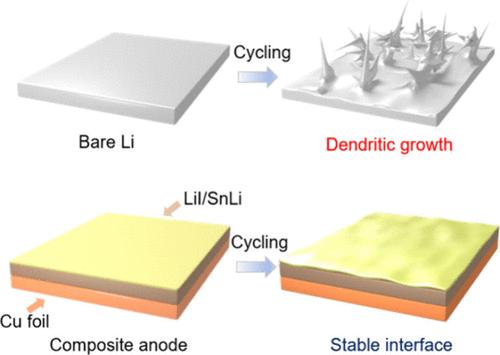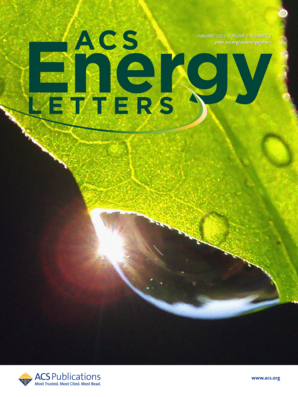LiI-Coated Li-Sn Alloy Composite Anode for Lithium Metal Batteries with Solid Polymer Electrolyte
IF 19.3
1区 材料科学
Q1 CHEMISTRY, PHYSICAL
引用次数: 0
Abstract
Lithium metal batteries with solid-state polymer electrolytes have garnered significant attention for their enhanced safety and high energy density. However, dendrite growth and interfacial reactions with lithium metal anodes impede their commercial viability. In this study, a LiI-coated SnLi alloy composite anode was proposed to address these critical issues. The SnLi alloy provides nucleation sites, suppressing dendrite formation, while the LiI-enriched coating reduces side reactions with the polymer electrolyte, minimizing lithium consumption. As a result, a symmetrical cell with the fabricated LiI/SnLi anode and PVDF solid polymer electrolyte (SPE) exhibits a cycling life of 2500 h. Furthermore, the LiFePO4|PVDF-SPE|LiI/SnLi battery cycles stably over 1000 cycles. When the cathode was replaced with LiNi0.6Co0.2Mn0.2O2, the battery maintained 73.3% capacity over 600 cycles. Notably, this coin cell sustains a stable electrochemical performance even under a high loading of NCM622 (10.2 mg cm–2) and a low N/P ratio of 4.8 over 150 cycles.

采用固体聚合物电解质的锂金属电池用 LiI 涂层锂锰合金复合负极
采用固态聚合物电解质的锂金属电池因其更高的安全性和能量密度而备受关注。然而,锂金属阳极的枝晶生长和界面反应阻碍了其商业可行性。本研究提出了一种锂离子涂层锡锂合金复合阳极来解决这些关键问题。SnLi 合金提供了成核点,抑制了枝晶的形成,而富含 LiI 的涂层则减少了与聚合物电解质的副反应,最大限度地降低了锂消耗。因此,使用制备的 LiI/SnLi 阳极和 PVDF 固体聚合物电解质(SPE)的对称电池的循环寿命达到了 2500 小时。当正极换成 LiNi0.6Co0.2Mn0.2O2 时,电池在 600 次循环中保持了 73.3% 的容量。值得注意的是,即使在高 NCM622 负载(10.2 mg cm-2)和低 N/P 比(4.8)的情况下,这种纽扣电池也能在 150 次循环中保持稳定的电化学性能。
本文章由计算机程序翻译,如有差异,请以英文原文为准。
求助全文
约1分钟内获得全文
求助全文
来源期刊

ACS Energy Letters
Energy-Renewable Energy, Sustainability and the Environment
CiteScore
31.20
自引率
5.00%
发文量
469
审稿时长
1 months
期刊介绍:
ACS Energy Letters is a monthly journal that publishes papers reporting new scientific advances in energy research. The journal focuses on topics that are of interest to scientists working in the fundamental and applied sciences. Rapid publication is a central criterion for acceptance, and the journal is known for its quick publication times, with an average of 4-6 weeks from submission to web publication in As Soon As Publishable format.
ACS Energy Letters is ranked as the number one journal in the Web of Science Electrochemistry category. It also ranks within the top 10 journals for Physical Chemistry, Energy & Fuels, and Nanoscience & Nanotechnology.
The journal offers several types of articles, including Letters, Energy Express, Perspectives, Reviews, Editorials, Viewpoints and Energy Focus. Additionally, authors have the option to submit videos that summarize or support the information presented in a Perspective or Review article, which can be highlighted on the journal's website. ACS Energy Letters is abstracted and indexed in Chemical Abstracts Service/SciFinder, EBSCO-summon, PubMed, Web of Science, Scopus and Portico.
 求助内容:
求助内容: 应助结果提醒方式:
应助结果提醒方式:


